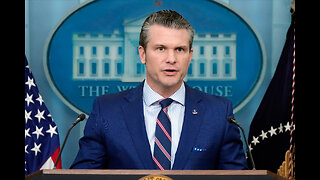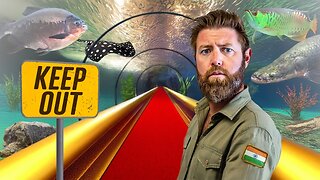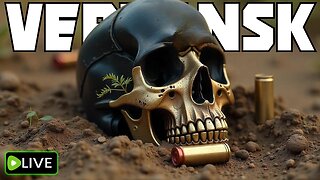Premium Only Content

The Grassland Biome - Biomes #5
Grass. If there is one plant that has come to dominate our world, it’s this. Occupying every biome on earth except the icesheets, grasses have colonised every patch of soil, from tropical to temperate forests, savannah to steppe, scrubland to desert. Humans have taken these grasses and shaped them over generations into crops that feed the world today. Their homelands are the seas of grass we call Meadow, Prairie, Pampas, Veldt and Steppe - the world’s Grasslands.
🕐TIMESTAMPS🕖
0:00 Opening Montage
0:51 Introduction and Titles
1:48 What is Grass?
2:31 Grasslands vs Savannah
2:57 Related Climate Zones
3:19 Holdridge Lifezones Chart
3:36 Prairie, Steppe, Pampas, Veldt
5:01 Global Distribution, North America
6:15 South American Grasslands
6:48 Grasslands in Africa, New Zealand
7:20 Eurasian Grasslands
8:16 Grassland Plant Species
8:45 Grassland Fauna, Wildlife
9:11 Ecosystem Threats, Agriculture
10:00 Outro
Prairie is almost exclusively used to refer to the grasslands of North America, and is a word borrowed from the early French settlers to this region, meaning simply “meadow” in that language. Steppe refers mostly to the grasslands of Eurasia, and is taken directly from the Russian word for this biome. Pampas is the most common word for the extensive grasslands of mid-southern South America and is from the Quechua word for plain. Veldt, the Afrikaans word for field, is a loose term to describe the open upland country of eastern South Africa that is sometimes grassland but might also be scrub.
Grasslands can be found in these countries: Canada, USA, Peru, Bolivia, Argentina, Brazil, Uruguay, South Africa, New Zealand, Turkey, Iran, Ukraine, Russia, Kazakhstan, Mongolia and China.
The domestication of various species of the grass family into cereal crops is regarded as one of the key developments of human civilisation. Wheat, corn, rice, barley, oats, millet, sugar and many more crops that directly, or through fodder for livestock, feed us, are all grasses. And so this humble family of plants that colonised the world and later went onto feed ours can be thought of in many ways as the most important in our world.
- -
FURTHER READING:
LONS08 - A new world natural vegetation map for global change studies - http://www.scielo.br/pdf/aabc/v80n2/a17v80n2.pdf
Holdridge Life Zones - https://www.researchgate.net/figure/Holdridge-Life-Zones-classification-system-2_fig3_274460180
Additional charts, maps and images along with the narrative script - click here:
👉 https://geodiode.com/biomes/grasslands
- -
📷📹🎥 VIDEO & PHOTO CREDITS ❤️❤️❤️
http://geodiode.com/biomes/grasslands#credits
--
Please support the development of this channel by remembering to 👍 Like, 🔁 Share and 🔴 Subscribe.
You can also support the production of series like this by becoming a monthly sponsor with Patreon for as little as $2/month 👉 https://patreon.com/geodiode 🥰
Research and Media Procurement Assistance, Spanish CC Translation: Richard Torres
Narrated, Written and Produced by
B.J.Ranson
You can contact me via the website at 👉 https://geodiode.com/contact
Or you can send an email via this Youtube Channel page 👉 https://www.youtube.com/channel/UC1raaXFgsFBSFR8qNgchF2g/about
-
 26:56
26:56
Geodiode - Exploring Our World Through Video
2 years ago $0.05 earnedThe History of Scotland
6911 -
 LIVE
LIVE
Right Side Broadcasting Network
9 hours agoLIVE: Defense Secretary Pete Hegseth and Gen. Dan Caine Hold a Pentagon Press Briefing - 6/22/25
20,307 watching -
 LIVE
LIVE
Barry Cunningham
31 minutes agoLIVE: Defense Secretary Pete Hegseth & Gen. Dan Caine Hold a Pentagon Press Briefing On Iran Bombing
1,862 watching -
 15:53
15:53
Forrest Galante
2 hours agoPrivate Tour of India’s Best Secret Aquarium
3.44K2 -
 LIVE
LIVE
NEWSMAX
6 months agoNEWSMAX2 LIVE | Real News for Real People
2,564 watching -
 LIVE
LIVE
Joe Donuts Live
2 hours ago🟢LIVE with the BOYS : Tales From The Gulag
99 watching -
 LIVE
LIVE
Boxin
2 hours agoToday We start Fable 2!
749 watching -
 25:23
25:23
The Connect: With Johnny Mitchell
1 day ago $1.12 earnedWhy They're Lying To You About The LA Riots, ICE Raids, & The Future Surveillance State
10.8K18 -
 2:38:44
2:38:44
The Charlie Kirk Show
11 hours agoLIVE: US Bombs Iran - Trump Speaking Soon
458K722 -
 58:03
58:03
FRENCHY4185
1 hour agoSPLITGATE 2 : PLAYING W/ FOLLOWERS
1.39K